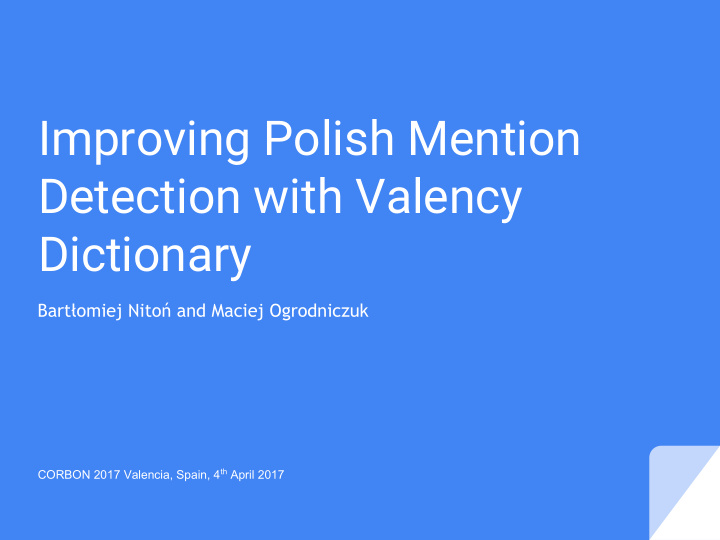



Improving Polish Mention Detection with Valency Dictionary Bartłomiej Nitoń and Maciej Ogrodniczuk CORBON 2017 Valencia, Spain, 4 th April 2017
The case of mention borders A mention – text fragment which could potentially create references to discourse world objects. Inclusion of extensive syntactically dependent phrases into mention borders is important due to semantic understanding of mentions: ● pierwszy człowiek na Księżycu ’the first man on the Moon’ samochód, który potrącił moją żonę ’the car which hit my wife’ ●
Mention components (highlights) nouns in genitive, e.g. kolega brata ‘a friend of my brother’ ● ● adjectives / adjective participles adjusting their form to the superordinate noun, e.g. kolorowe kwiaty ‘colourful flowers’, nadchodzące zmiany ‘oncoming changes’ ● adverbs as adjectives and participle modifiers, e.g. szalenie ciekawy film ‘incredibly interesting film’ ● prepositional-nominal phrases, e.g. ustawa o podatku dochodowym ‘the law on income tax’ ● relative clauses, e.g. dziewczyna, o której rozmawialiśmy ‘the girl we talked about’
State-of-the-art for Polish No (sufficiently effective) constituency parser to detect mentions. Rule based tool combining information on: ● single-segment nouns and nominal groups, detected with Spejd shallow parser fitted with an adaptation of the National Corpus of Polish grammar pronouns, identified with a disambiguating morphosyntactic tagger ● with a morphological analyser and lemmatizer Morfeusz zero subjects, detected using machine learned model ● ● nominal named entities, detected with Nerf named entity recognizer
Mention detection improvements Observation: valence schemata can bring improvements to mention detection. verbal schemata: confuse sb with sb ● → never link (sb with sb) ● nominal schemata: conflict of sb with sb → always link (conflict of sb with sb)
Walenty: a source of syntactic schemata Walenty is a comprehensive human- and machine-readable dictionary of Polish valency information for verbs, nouns, adjectives and adverbs: over 12 000 verbs (> 67 000 syntactic schemata) ● ● about 3 000 nouns (> 18 000 syntactic schemata) about 1 000 adjectives (> 4 000 syntactic schemata) ● ● about 200 adverbs (> 1 000 syntactic schemata) And is still expanding...
Walenty (example schema) Potężne [komputery] SUBJ [łączą] VERB [firmę] OBJ [światłowodami] NP(INST) [z cyfrowym światem] PREPNP(Z,INST) . ‘Powerful [computers] SUBJ [link] VERB [the company] OBJ [with the digital world] PREPNP(Z,INST) using [optical fiber] NP(INST) .’
Building Walenty phrase types Nominal and verbal rules use only np , prepnp , and comprepnp phrases: np( case ) ● prepnp( prep , case ) ● comprepnp( complex preposition ) ● Where: case is case of nominal or prepositional-nominal group head ● detected by Spejd prep is preposition word tagged by Spejd as Prep, starting detected ● prepositional-nominal group ● complex preposition is word tagged as Prep but consisting of more than one segment
Nominal realizations (merging) Od tamtego czasu miał miejsce [konflikt] NOUN [polskiego ambasadora] NP(GEN) [z polskim księdzem] PREPNP(Z,INST) . ’Since then there was [a conflict] NOUN [of the Polish ambassador] NP(GEN) [with the Polish priest] PREPNP(Z,INST) .’ [konflikt polskiego ambasadora z polskim księdzem] ‘[a conflict of the Polish ambassador with the Polish priest]’
Verbal realizations (cleaning) [Gratuluję] VERB [Włochom] NP(DAT) [awansu] NP(GEN) . ’I [congratulate] VERB [the Italians] NP(DAT) on their [promotion] NP(GEN) .’ [Włochom awansu] ‘[the Italians on their promotion]’
Secondary prepositions and phraseological compounds (cleaning) Removing mentions being part of frazeos: ● particle-adverbs (Qub), e.g. bez wątpienia ‘without a doubt’ secondary prepositions (Prep), e.g. na bazie ‘based on’ ● ● adverbs (Adv), e.g. w lot ’immediately’ ● interjections (Interj), e.g. broń Boże ’heaven forbid’ adjectives (Adj), e.g. na poziomie ’ambitious’ ● conjunctions (Conj), e.g. przy czym ’at the same time’ ● ● compounds (Comp), e.g. w miarę jak (słuchali) ’as (they listened)’
Polish Coreference Corpus (PCC) built upon the National Corpus of Polish ● about 1900 documents from 14 text genres ● about 540K tokens, 180K mentions and 128K coreference clusters ● ● each text is a 250–350 word sample consisting of full subsequent paragraphs extracted from a larger text ● a smaller subset of long texts (21), 1000 to 4000 segments per text ● nominal, pronominal, and zero mentions
Mention detection evaluation Precision, recall and F-measure were calculated using ● Scoreference Two alternative mention detection scores: EXACT boundary match ● and HEAD match.
Future plans ● analyse how other types of phrases intervene in the process of mention construction ● use dependency parser for mention detection instead of Spejd or try to use them both at a time ● check how mention detection score is rising with Walenty expansion (particularly with new noun entries)
Thank you...
Recommend
More recommend